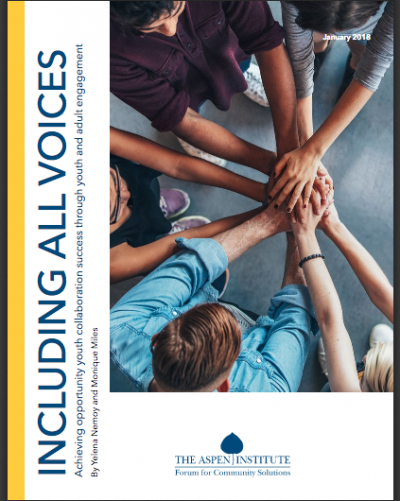
Addressing the intractable challenges that prevent young people from meeting their highest potential means more than just creating pathways for them to succeed. Successful youth engagement means bringing youth voices into the forefront, but how does that look, and what communities are doing it well?
Our new report, Including All Voices: Achieving Opportunity Youth Collaboration Success Through Youth and Adult Engagement, looks at local collaborative approaches to youth engagement that recognize youth and young adults as agents in their own growth and development and enlists them as partners in designing solutions to issues that impact them. The publication also highlights promising strategies in youth engagement and youth-led change and suggestions on how to expand these efforts so that youth are continually driving local and national policies.
Since 2012, the Aspen Institute Forum for Community Solutions’ Opportunity Youth Incentive Fund (OYIF) has worked with cross-sector, cross-system collaborative initiatives across the U.S. that are focused on building and deepening the education and employment opportunities for opportunity youth, who are 16- to 24-year-olds who are out of work and school.
The Aspen Forum does this by working with OYIF collaboratives that incorporate a range of youth engagement activities representing four stages of the youth engagement continuum:
- Basic Engagement: Youth and young adults provide discreet “customer feedback” and recommendations;
- Participatory Engagement: Youth and young adults have a seat at the local collaborative table;
- Influencing Programs and Systems: Youth and young adults advocate and work in partnership with adults to make key decisions in programming;
- Youth- and Young Adult-Led Change: Youth and young adults lead advocacy and programming.
Our partner, the Hopi Opportunity Youth Initiative (HOYI) of Kykotsmovi Village, Ariz., hosted youth listening sessions to better understand and empower Hopi and Tewa youth. HOYI also created a Youth Advisory Council (YAC) that brings together youth representatives of various Hopi youth groups.
“Youth want to better themselves and raise awareness,” said Lexie James, a recent high-school graduate who oversees the YAC. “And they are willing to meet you halfway if you make the effort to listen to them.”
Another example of this collaboration between youth and adults, is the Southern Maine Youth Transition Network (SMYTN). Young people attend meetings; sit on local, state, and national committees; train staff on working with opportunity youth; participate in public policy and practice conversations; and take on a variety of advisory roles. Young adults even have become paid interns and staff.
“As adults it is important we make space in this work to continue to question, assess, and reassess how much power, authority, and decision making we are really opening up to young people,” said Emily Thielmann of SMYTN. “The OYIF learning community supports us in exploring these sorts of questions.”
These examples indicate that bringing young people into the process has proved successful, yet collaboratives also have shared challenges to authentic young adult engagement. Learn more about the challenges, successes, and other tools that move the needle forward on youth engagement.
Click here to read the Executive Summary.
Click here to read the full report.